Research Report: ISO 9000 Adoption and Industry Factors in China
VerifiedAdded on 2023/03/31
|17
|3675
|268
Report
AI Summary
This report investigates the adoption of ISO 9000 certification and its relationship with other factors in China's service industry. The research utilizes data from the 2008 Economic Census of China, employing statistical methods such as Pearson correlation, Chi-square tests, t-tests, and ANOVA to analyze the relationships between ISO 9000 certification and variables including sales volume, number of employees, and capital from overseas. The findings indicate a positive correlation between ISO 9000 certification and higher sales volume, a larger number of employees, and increased capital from foreign countries. The study emphasizes the importance of ISO 9000 certification for improving firm performance in the Chinese service industry, while also suggesting the need for future research to consider the time-series aspects of the research problem. The report includes an executive summary, literature review, methodology, analysis, discussion, and references, providing a comprehensive overview of the adoption of ISO 9000 in the context of China's service sector.
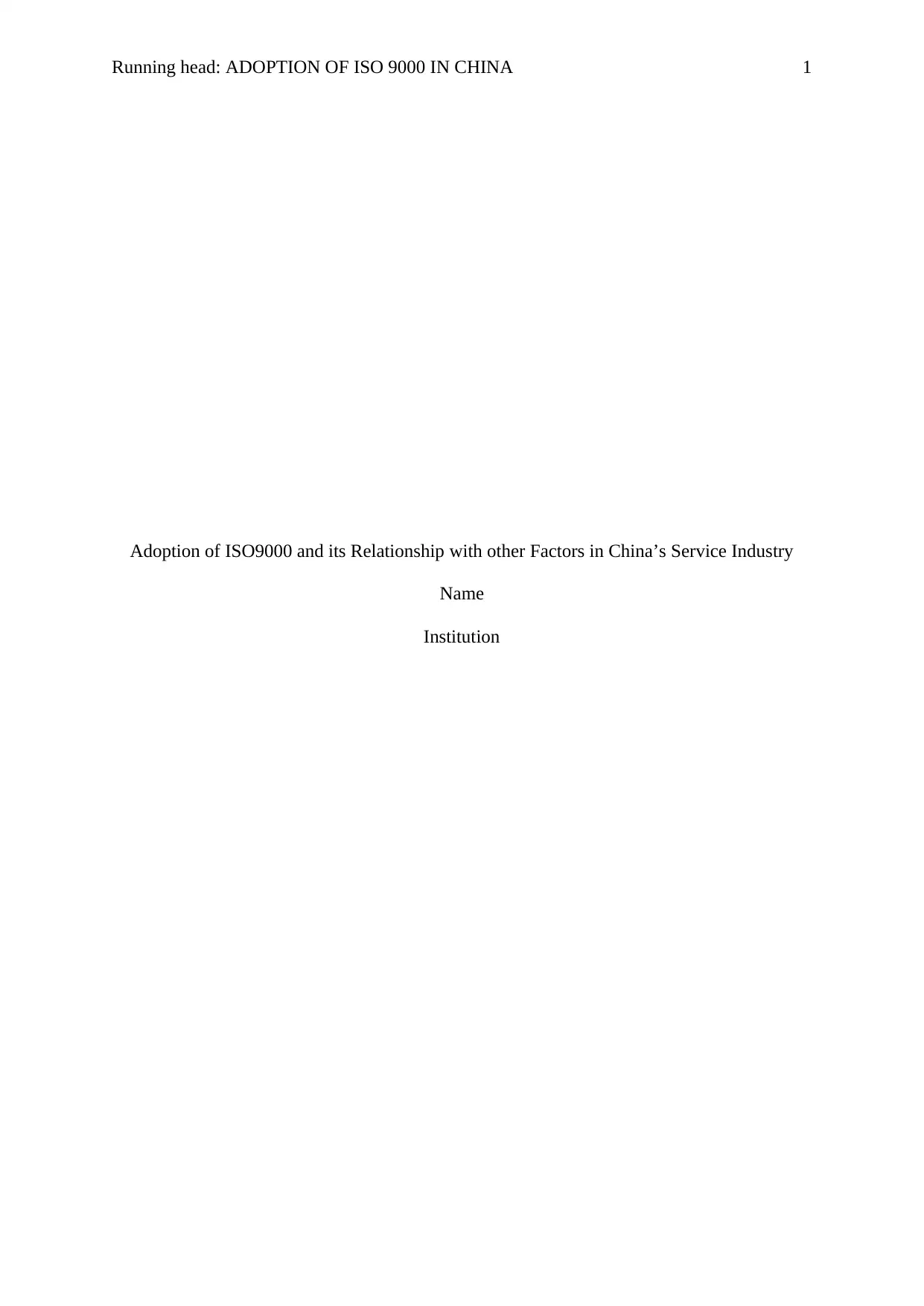
Running head: ADOPTION OF ISO 9000 IN CHINA 1
Adoption of ISO9000 and its Relationship with other Factors in China’s Service Industry
Name
Institution
Adoption of ISO9000 and its Relationship with other Factors in China’s Service Industry
Name
Institution
Paraphrase This Document
Need a fresh take? Get an instant paraphrase of this document with our AI Paraphraser
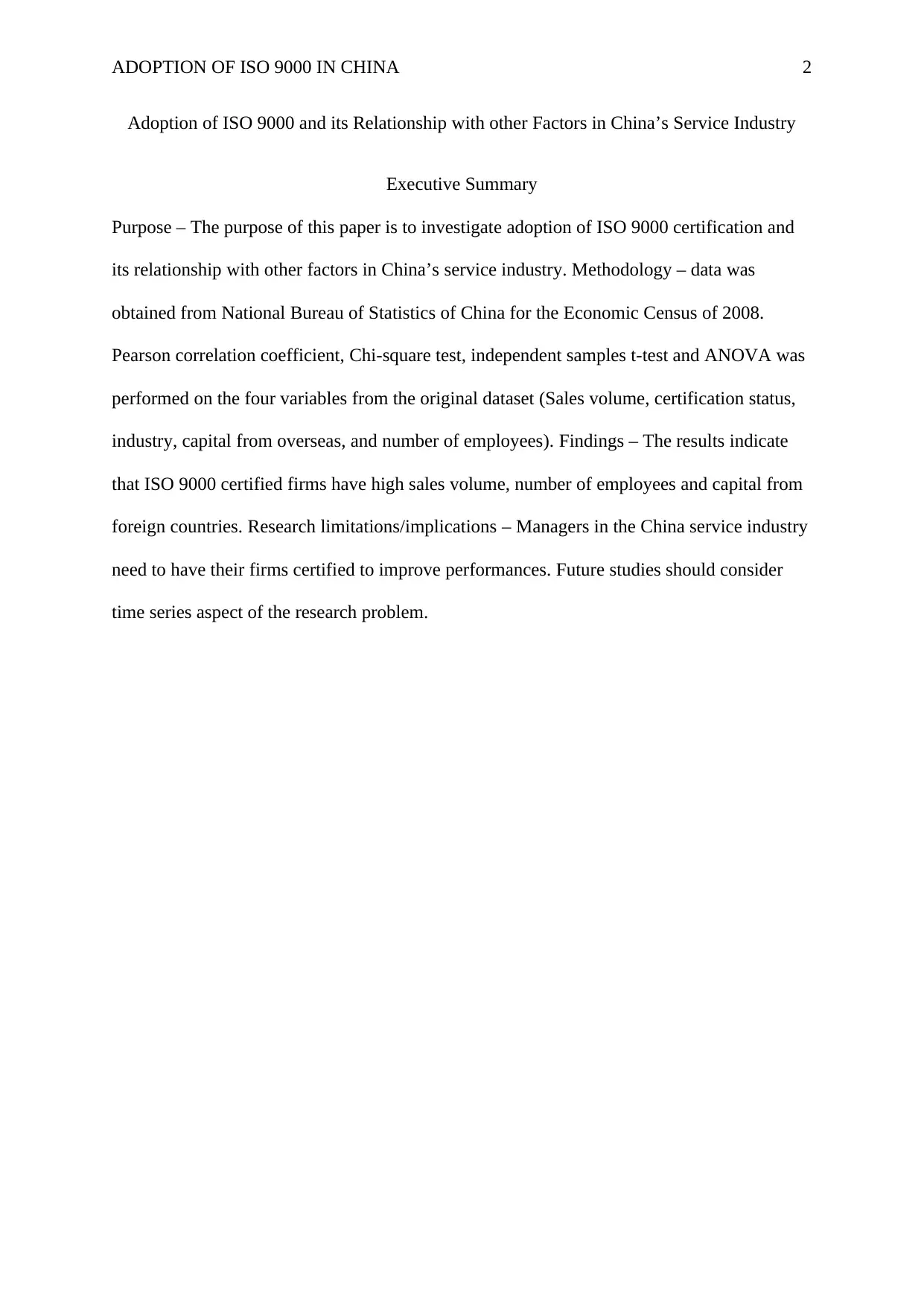
ADOPTION OF ISO 9000 IN CHINA 2
Adoption of ISO 9000 and its Relationship with other Factors in China’s Service Industry
Executive Summary
Purpose – The purpose of this paper is to investigate adoption of ISO 9000 certification and
its relationship with other factors in China’s service industry. Methodology – data was
obtained from National Bureau of Statistics of China for the Economic Census of 2008.
Pearson correlation coefficient, Chi-square test, independent samples t-test and ANOVA was
performed on the four variables from the original dataset (Sales volume, certification status,
industry, capital from overseas, and number of employees). Findings – The results indicate
that ISO 9000 certified firms have high sales volume, number of employees and capital from
foreign countries. Research limitations/implications – Managers in the China service industry
need to have their firms certified to improve performances. Future studies should consider
time series aspect of the research problem.
Adoption of ISO 9000 and its Relationship with other Factors in China’s Service Industry
Executive Summary
Purpose – The purpose of this paper is to investigate adoption of ISO 9000 certification and
its relationship with other factors in China’s service industry. Methodology – data was
obtained from National Bureau of Statistics of China for the Economic Census of 2008.
Pearson correlation coefficient, Chi-square test, independent samples t-test and ANOVA was
performed on the four variables from the original dataset (Sales volume, certification status,
industry, capital from overseas, and number of employees). Findings – The results indicate
that ISO 9000 certified firms have high sales volume, number of employees and capital from
foreign countries. Research limitations/implications – Managers in the China service industry
need to have their firms certified to improve performances. Future studies should consider
time series aspect of the research problem.
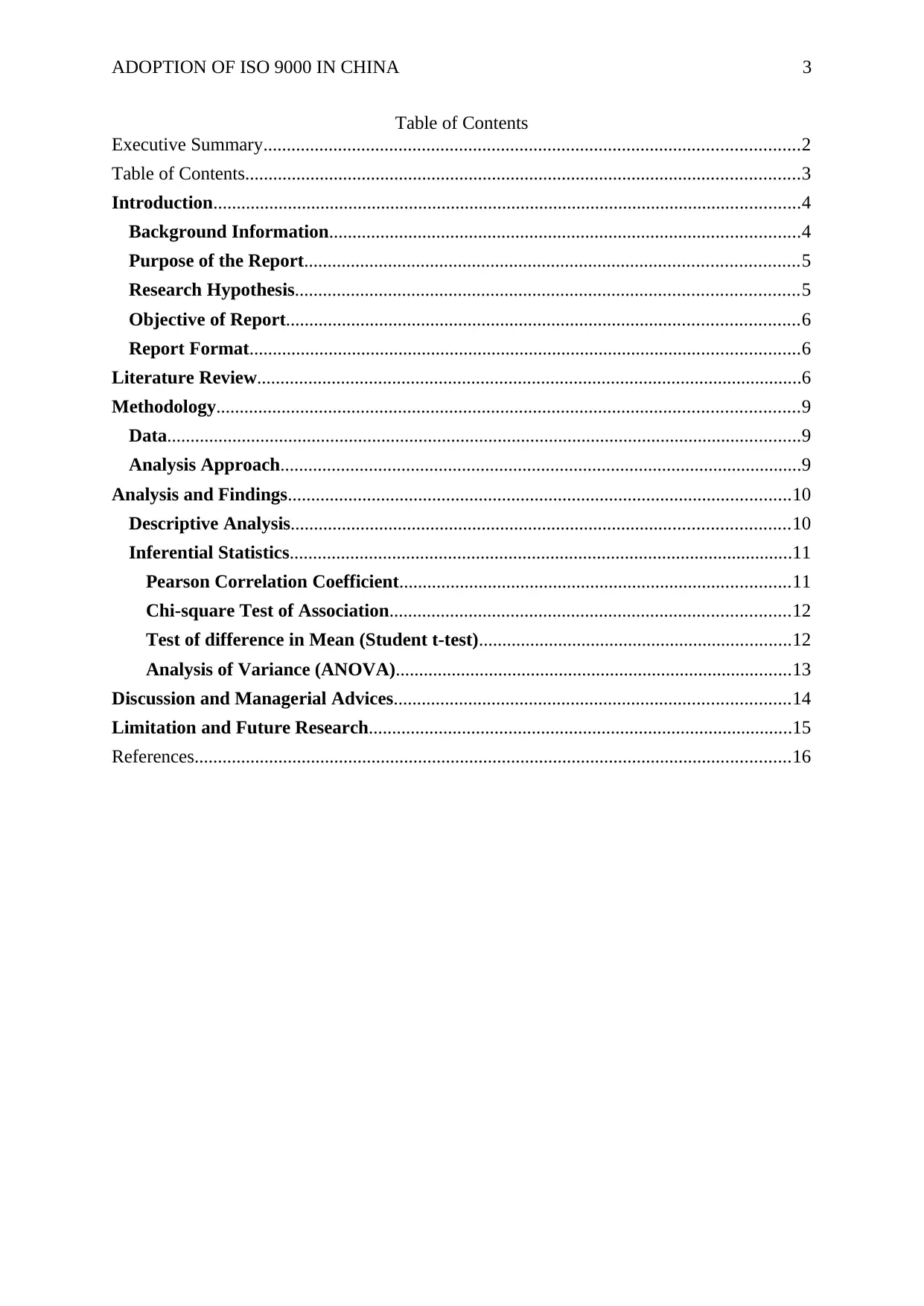
ADOPTION OF ISO 9000 IN CHINA 3
Table of Contents
Executive Summary...................................................................................................................2
Table of Contents.......................................................................................................................3
Introduction..............................................................................................................................4
Background Information.....................................................................................................4
Purpose of the Report..........................................................................................................5
Research Hypothesis............................................................................................................5
Objective of Report..............................................................................................................6
Report Format......................................................................................................................6
Literature Review.....................................................................................................................6
Methodology.............................................................................................................................9
Data........................................................................................................................................9
Analysis Approach................................................................................................................9
Analysis and Findings............................................................................................................10
Descriptive Analysis...........................................................................................................10
Inferential Statistics............................................................................................................11
Pearson Correlation Coefficient....................................................................................11
Chi-square Test of Association......................................................................................12
Test of difference in Mean (Student t-test)...................................................................12
Analysis of Variance (ANOVA).....................................................................................13
Discussion and Managerial Advices.....................................................................................14
Limitation and Future Research...........................................................................................15
References................................................................................................................................16
Table of Contents
Executive Summary...................................................................................................................2
Table of Contents.......................................................................................................................3
Introduction..............................................................................................................................4
Background Information.....................................................................................................4
Purpose of the Report..........................................................................................................5
Research Hypothesis............................................................................................................5
Objective of Report..............................................................................................................6
Report Format......................................................................................................................6
Literature Review.....................................................................................................................6
Methodology.............................................................................................................................9
Data........................................................................................................................................9
Analysis Approach................................................................................................................9
Analysis and Findings............................................................................................................10
Descriptive Analysis...........................................................................................................10
Inferential Statistics............................................................................................................11
Pearson Correlation Coefficient....................................................................................11
Chi-square Test of Association......................................................................................12
Test of difference in Mean (Student t-test)...................................................................12
Analysis of Variance (ANOVA).....................................................................................13
Discussion and Managerial Advices.....................................................................................14
Limitation and Future Research...........................................................................................15
References................................................................................................................................16
⊘ This is a preview!⊘
Do you want full access?
Subscribe today to unlock all pages.

Trusted by 1+ million students worldwide
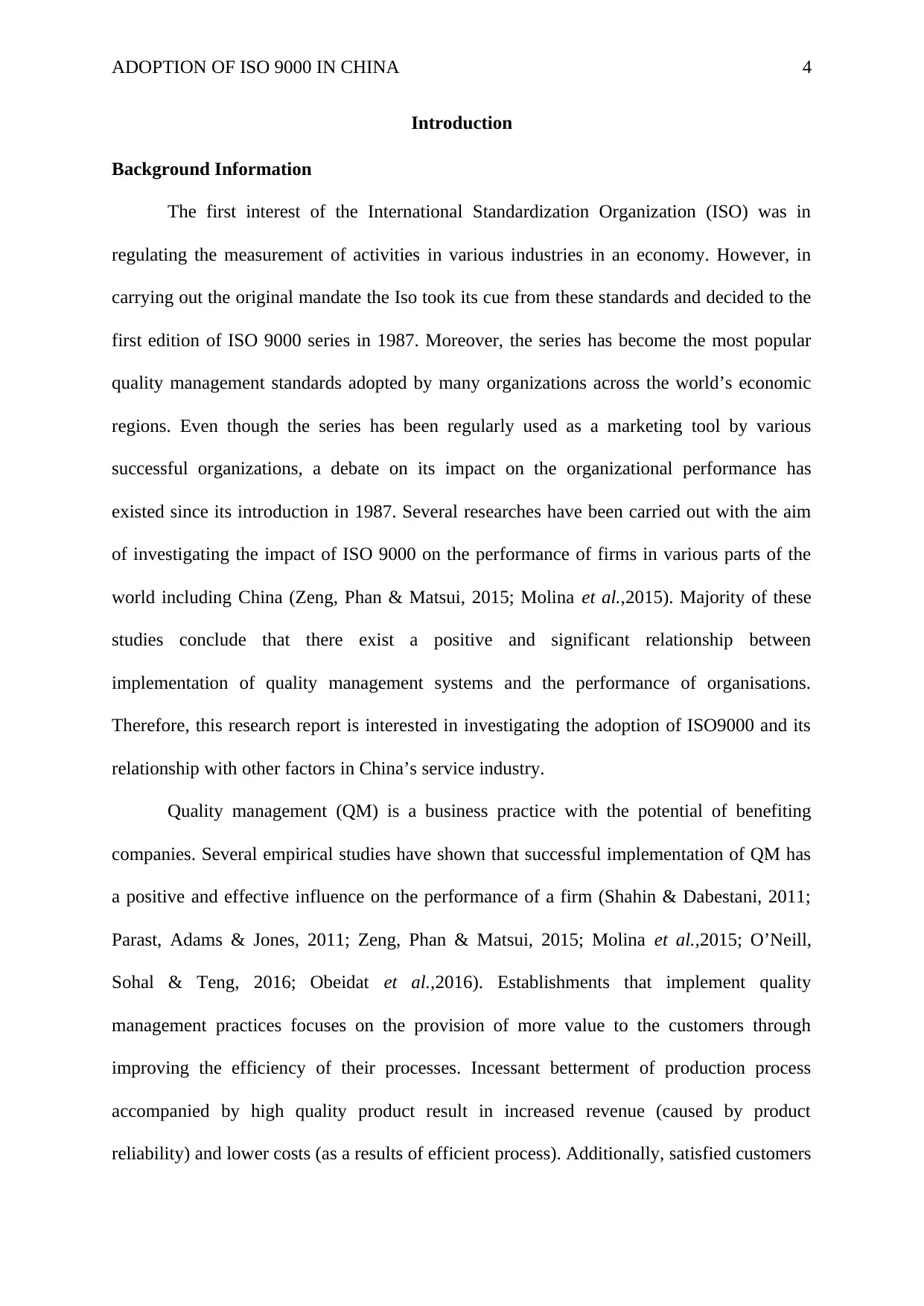
ADOPTION OF ISO 9000 IN CHINA 4
Introduction
Background Information
The first interest of the International Standardization Organization (ISO) was in
regulating the measurement of activities in various industries in an economy. However, in
carrying out the original mandate the Iso took its cue from these standards and decided to the
first edition of ISO 9000 series in 1987. Moreover, the series has become the most popular
quality management standards adopted by many organizations across the world’s economic
regions. Even though the series has been regularly used as a marketing tool by various
successful organizations, a debate on its impact on the organizational performance has
existed since its introduction in 1987. Several researches have been carried out with the aim
of investigating the impact of ISO 9000 on the performance of firms in various parts of the
world including China (Zeng, Phan & Matsui, 2015; Molina et al.,2015). Majority of these
studies conclude that there exist a positive and significant relationship between
implementation of quality management systems and the performance of organisations.
Therefore, this research report is interested in investigating the adoption of ISO9000 and its
relationship with other factors in China’s service industry.
Quality management (QM) is a business practice with the potential of benefiting
companies. Several empirical studies have shown that successful implementation of QM has
a positive and effective influence on the performance of a firm (Shahin & Dabestani, 2011;
Parast, Adams & Jones, 2011; Zeng, Phan & Matsui, 2015; Molina et al.,2015; O’Neill,
Sohal & Teng, 2016; Obeidat et al.,2016). Establishments that implement quality
management practices focuses on the provision of more value to the customers through
improving the efficiency of their processes. Incessant betterment of production process
accompanied by high quality product result in increased revenue (caused by product
reliability) and lower costs (as a results of efficient process). Additionally, satisfied customers
Introduction
Background Information
The first interest of the International Standardization Organization (ISO) was in
regulating the measurement of activities in various industries in an economy. However, in
carrying out the original mandate the Iso took its cue from these standards and decided to the
first edition of ISO 9000 series in 1987. Moreover, the series has become the most popular
quality management standards adopted by many organizations across the world’s economic
regions. Even though the series has been regularly used as a marketing tool by various
successful organizations, a debate on its impact on the organizational performance has
existed since its introduction in 1987. Several researches have been carried out with the aim
of investigating the impact of ISO 9000 on the performance of firms in various parts of the
world including China (Zeng, Phan & Matsui, 2015; Molina et al.,2015). Majority of these
studies conclude that there exist a positive and significant relationship between
implementation of quality management systems and the performance of organisations.
Therefore, this research report is interested in investigating the adoption of ISO9000 and its
relationship with other factors in China’s service industry.
Quality management (QM) is a business practice with the potential of benefiting
companies. Several empirical studies have shown that successful implementation of QM has
a positive and effective influence on the performance of a firm (Shahin & Dabestani, 2011;
Parast, Adams & Jones, 2011; Zeng, Phan & Matsui, 2015; Molina et al.,2015; O’Neill,
Sohal & Teng, 2016; Obeidat et al.,2016). Establishments that implement quality
management practices focuses on the provision of more value to the customers through
improving the efficiency of their processes. Incessant betterment of production process
accompanied by high quality product result in increased revenue (caused by product
reliability) and lower costs (as a results of efficient process). Additionally, satisfied customers
Paraphrase This Document
Need a fresh take? Get an instant paraphrase of this document with our AI Paraphraser
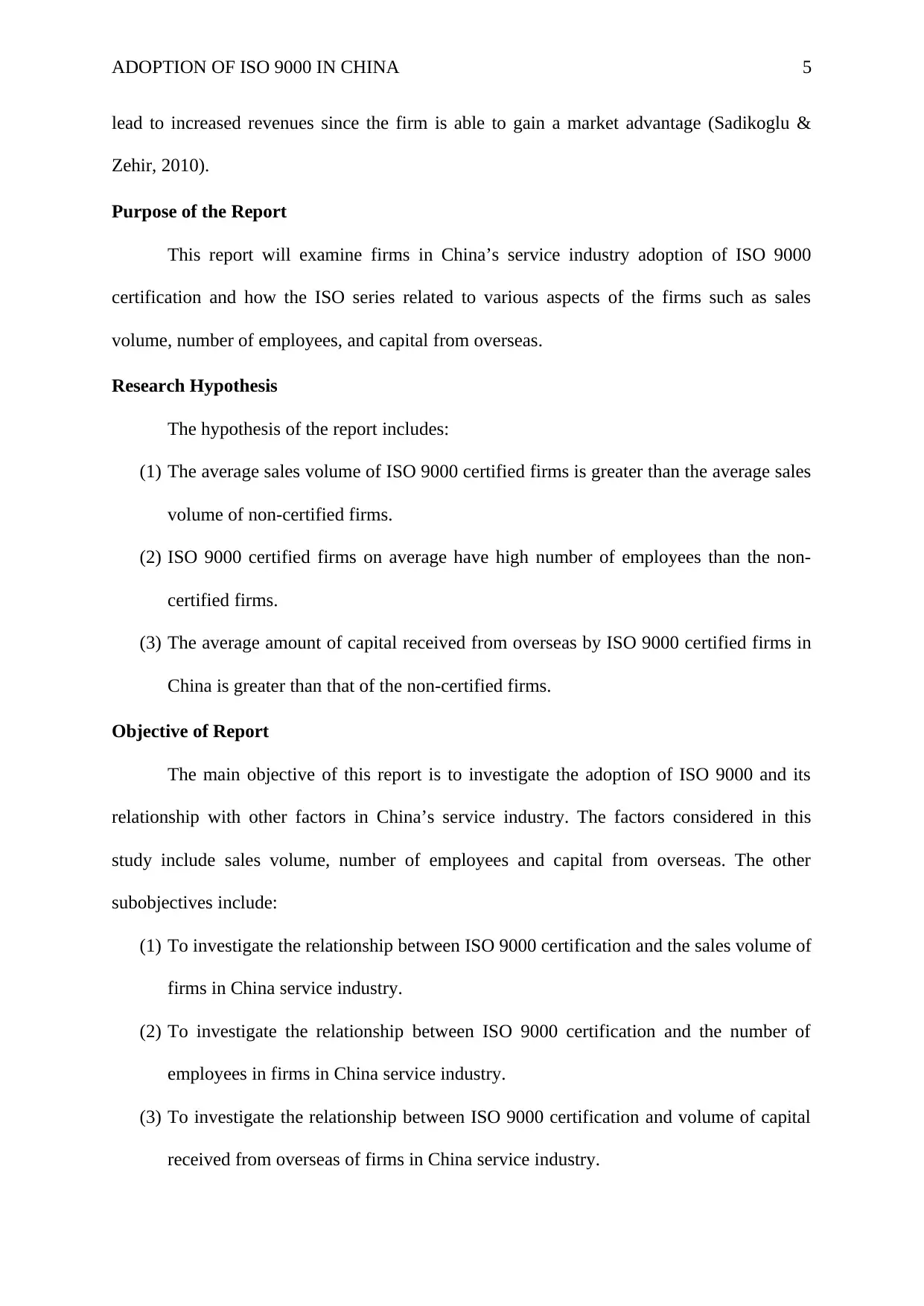
ADOPTION OF ISO 9000 IN CHINA 5
lead to increased revenues since the firm is able to gain a market advantage (Sadikoglu &
Zehir, 2010).
Purpose of the Report
This report will examine firms in China’s service industry adoption of ISO 9000
certification and how the ISO series related to various aspects of the firms such as sales
volume, number of employees, and capital from overseas.
Research Hypothesis
The hypothesis of the report includes:
(1) The average sales volume of ISO 9000 certified firms is greater than the average sales
volume of non-certified firms.
(2) ISO 9000 certified firms on average have high number of employees than the non-
certified firms.
(3) The average amount of capital received from overseas by ISO 9000 certified firms in
China is greater than that of the non-certified firms.
Objective of Report
The main objective of this report is to investigate the adoption of ISO 9000 and its
relationship with other factors in China’s service industry. The factors considered in this
study include sales volume, number of employees and capital from overseas. The other
subobjectives include:
(1) To investigate the relationship between ISO 9000 certification and the sales volume of
firms in China service industry.
(2) To investigate the relationship between ISO 9000 certification and the number of
employees in firms in China service industry.
(3) To investigate the relationship between ISO 9000 certification and volume of capital
received from overseas of firms in China service industry.
lead to increased revenues since the firm is able to gain a market advantage (Sadikoglu &
Zehir, 2010).
Purpose of the Report
This report will examine firms in China’s service industry adoption of ISO 9000
certification and how the ISO series related to various aspects of the firms such as sales
volume, number of employees, and capital from overseas.
Research Hypothesis
The hypothesis of the report includes:
(1) The average sales volume of ISO 9000 certified firms is greater than the average sales
volume of non-certified firms.
(2) ISO 9000 certified firms on average have high number of employees than the non-
certified firms.
(3) The average amount of capital received from overseas by ISO 9000 certified firms in
China is greater than that of the non-certified firms.
Objective of Report
The main objective of this report is to investigate the adoption of ISO 9000 and its
relationship with other factors in China’s service industry. The factors considered in this
study include sales volume, number of employees and capital from overseas. The other
subobjectives include:
(1) To investigate the relationship between ISO 9000 certification and the sales volume of
firms in China service industry.
(2) To investigate the relationship between ISO 9000 certification and the number of
employees in firms in China service industry.
(3) To investigate the relationship between ISO 9000 certification and volume of capital
received from overseas of firms in China service industry.
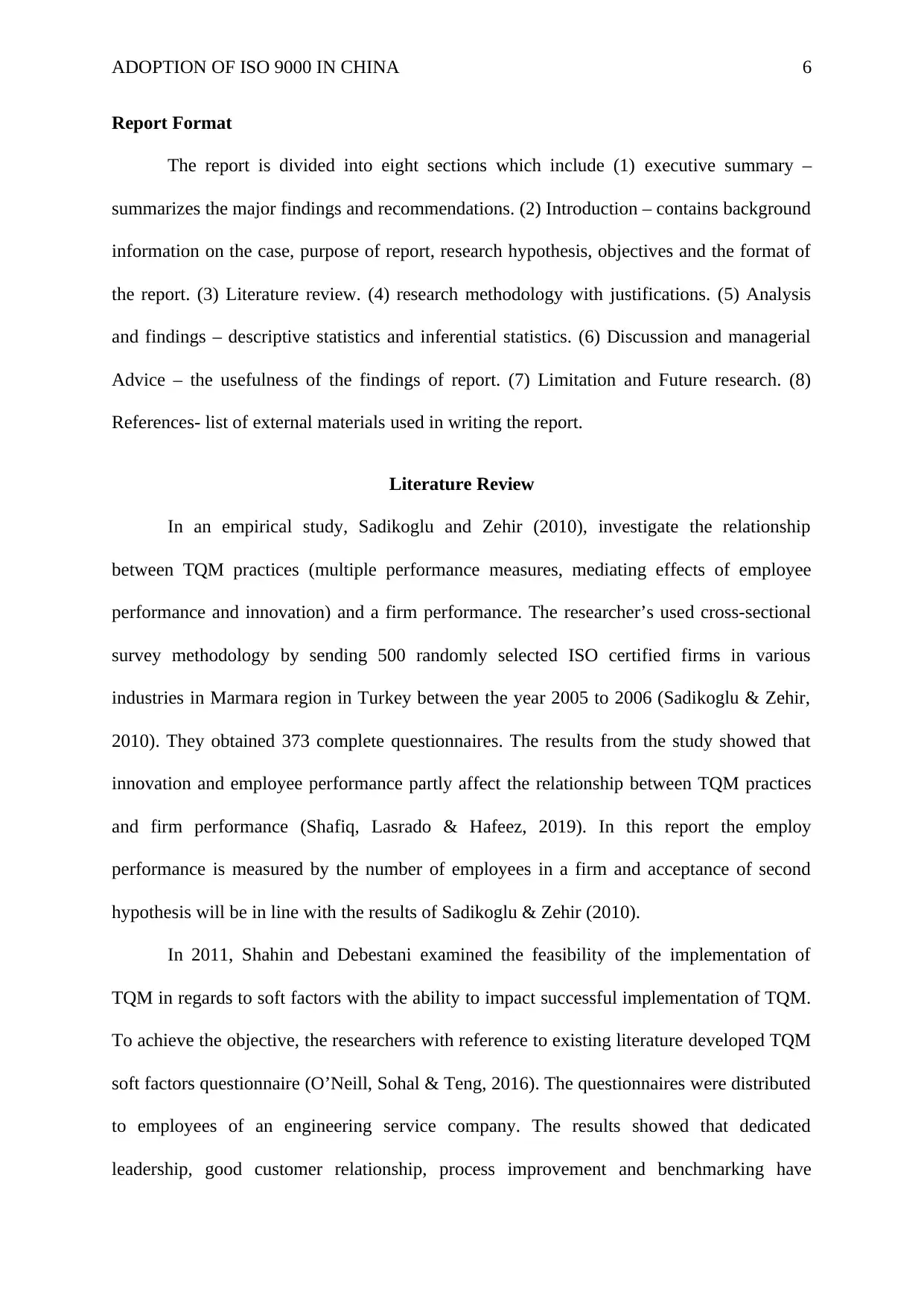
ADOPTION OF ISO 9000 IN CHINA 6
Report Format
The report is divided into eight sections which include (1) executive summary –
summarizes the major findings and recommendations. (2) Introduction – contains background
information on the case, purpose of report, research hypothesis, objectives and the format of
the report. (3) Literature review. (4) research methodology with justifications. (5) Analysis
and findings – descriptive statistics and inferential statistics. (6) Discussion and managerial
Advice – the usefulness of the findings of report. (7) Limitation and Future research. (8)
References- list of external materials used in writing the report.
Literature Review
In an empirical study, Sadikoglu and Zehir (2010), investigate the relationship
between TQM practices (multiple performance measures, mediating effects of employee
performance and innovation) and a firm performance. The researcher’s used cross-sectional
survey methodology by sending 500 randomly selected ISO certified firms in various
industries in Marmara region in Turkey between the year 2005 to 2006 (Sadikoglu & Zehir,
2010). They obtained 373 complete questionnaires. The results from the study showed that
innovation and employee performance partly affect the relationship between TQM practices
and firm performance (Shafiq, Lasrado & Hafeez, 2019). In this report the employ
performance is measured by the number of employees in a firm and acceptance of second
hypothesis will be in line with the results of Sadikoglu & Zehir (2010).
In 2011, Shahin and Debestani examined the feasibility of the implementation of
TQM in regards to soft factors with the ability to impact successful implementation of TQM.
To achieve the objective, the researchers with reference to existing literature developed TQM
soft factors questionnaire (O’Neill, Sohal & Teng, 2016). The questionnaires were distributed
to employees of an engineering service company. The results showed that dedicated
leadership, good customer relationship, process improvement and benchmarking have
Report Format
The report is divided into eight sections which include (1) executive summary –
summarizes the major findings and recommendations. (2) Introduction – contains background
information on the case, purpose of report, research hypothesis, objectives and the format of
the report. (3) Literature review. (4) research methodology with justifications. (5) Analysis
and findings – descriptive statistics and inferential statistics. (6) Discussion and managerial
Advice – the usefulness of the findings of report. (7) Limitation and Future research. (8)
References- list of external materials used in writing the report.
Literature Review
In an empirical study, Sadikoglu and Zehir (2010), investigate the relationship
between TQM practices (multiple performance measures, mediating effects of employee
performance and innovation) and a firm performance. The researcher’s used cross-sectional
survey methodology by sending 500 randomly selected ISO certified firms in various
industries in Marmara region in Turkey between the year 2005 to 2006 (Sadikoglu & Zehir,
2010). They obtained 373 complete questionnaires. The results from the study showed that
innovation and employee performance partly affect the relationship between TQM practices
and firm performance (Shafiq, Lasrado & Hafeez, 2019). In this report the employ
performance is measured by the number of employees in a firm and acceptance of second
hypothesis will be in line with the results of Sadikoglu & Zehir (2010).
In 2011, Shahin and Debestani examined the feasibility of the implementation of
TQM in regards to soft factors with the ability to impact successful implementation of TQM.
To achieve the objective, the researchers with reference to existing literature developed TQM
soft factors questionnaire (O’Neill, Sohal & Teng, 2016). The questionnaires were distributed
to employees of an engineering service company. The results showed that dedicated
leadership, good customer relationship, process improvement and benchmarking have
⊘ This is a preview!⊘
Do you want full access?
Subscribe today to unlock all pages.

Trusted by 1+ million students worldwide
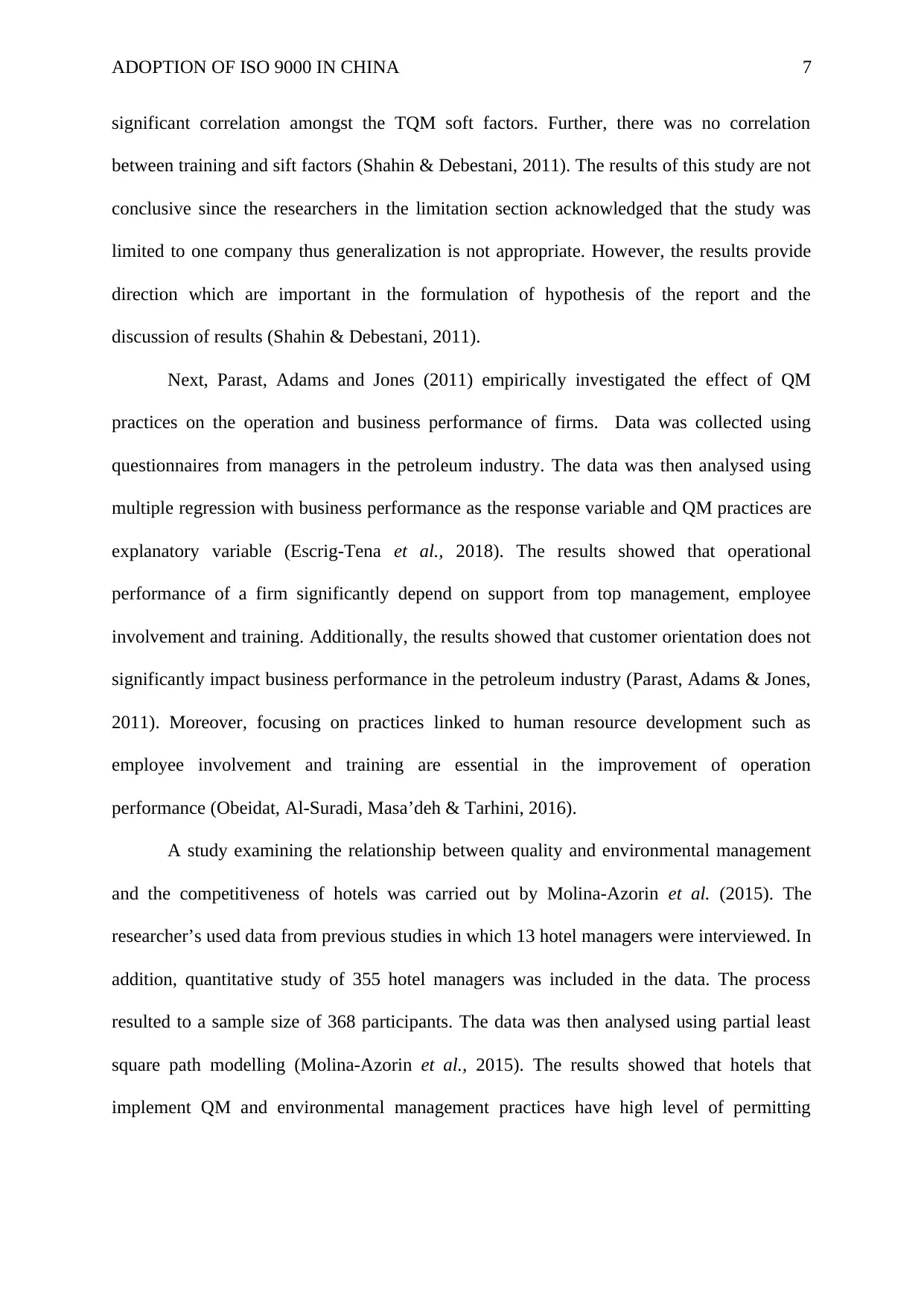
ADOPTION OF ISO 9000 IN CHINA 7
significant correlation amongst the TQM soft factors. Further, there was no correlation
between training and sift factors (Shahin & Debestani, 2011). The results of this study are not
conclusive since the researchers in the limitation section acknowledged that the study was
limited to one company thus generalization is not appropriate. However, the results provide
direction which are important in the formulation of hypothesis of the report and the
discussion of results (Shahin & Debestani, 2011).
Next, Parast, Adams and Jones (2011) empirically investigated the effect of QM
practices on the operation and business performance of firms. Data was collected using
questionnaires from managers in the petroleum industry. The data was then analysed using
multiple regression with business performance as the response variable and QM practices are
explanatory variable (Escrig-Tena et al., 2018). The results showed that operational
performance of a firm significantly depend on support from top management, employee
involvement and training. Additionally, the results showed that customer orientation does not
significantly impact business performance in the petroleum industry (Parast, Adams & Jones,
2011). Moreover, focusing on practices linked to human resource development such as
employee involvement and training are essential in the improvement of operation
performance (Obeidat, Al-Suradi, Masa’deh & Tarhini, 2016).
A study examining the relationship between quality and environmental management
and the competitiveness of hotels was carried out by Molina-Azorin et al. (2015). The
researcher’s used data from previous studies in which 13 hotel managers were interviewed. In
addition, quantitative study of 355 hotel managers was included in the data. The process
resulted to a sample size of 368 participants. The data was then analysed using partial least
square path modelling (Molina-Azorin et al., 2015). The results showed that hotels that
implement QM and environmental management practices have high level of permitting
significant correlation amongst the TQM soft factors. Further, there was no correlation
between training and sift factors (Shahin & Debestani, 2011). The results of this study are not
conclusive since the researchers in the limitation section acknowledged that the study was
limited to one company thus generalization is not appropriate. However, the results provide
direction which are important in the formulation of hypothesis of the report and the
discussion of results (Shahin & Debestani, 2011).
Next, Parast, Adams and Jones (2011) empirically investigated the effect of QM
practices on the operation and business performance of firms. Data was collected using
questionnaires from managers in the petroleum industry. The data was then analysed using
multiple regression with business performance as the response variable and QM practices are
explanatory variable (Escrig-Tena et al., 2018). The results showed that operational
performance of a firm significantly depend on support from top management, employee
involvement and training. Additionally, the results showed that customer orientation does not
significantly impact business performance in the petroleum industry (Parast, Adams & Jones,
2011). Moreover, focusing on practices linked to human resource development such as
employee involvement and training are essential in the improvement of operation
performance (Obeidat, Al-Suradi, Masa’deh & Tarhini, 2016).
A study examining the relationship between quality and environmental management
and the competitiveness of hotels was carried out by Molina-Azorin et al. (2015). The
researcher’s used data from previous studies in which 13 hotel managers were interviewed. In
addition, quantitative study of 355 hotel managers was included in the data. The process
resulted to a sample size of 368 participants. The data was then analysed using partial least
square path modelling (Molina-Azorin et al., 2015). The results showed that hotels that
implement QM and environmental management practices have high level of permitting
Paraphrase This Document
Need a fresh take? Get an instant paraphrase of this document with our AI Paraphraser
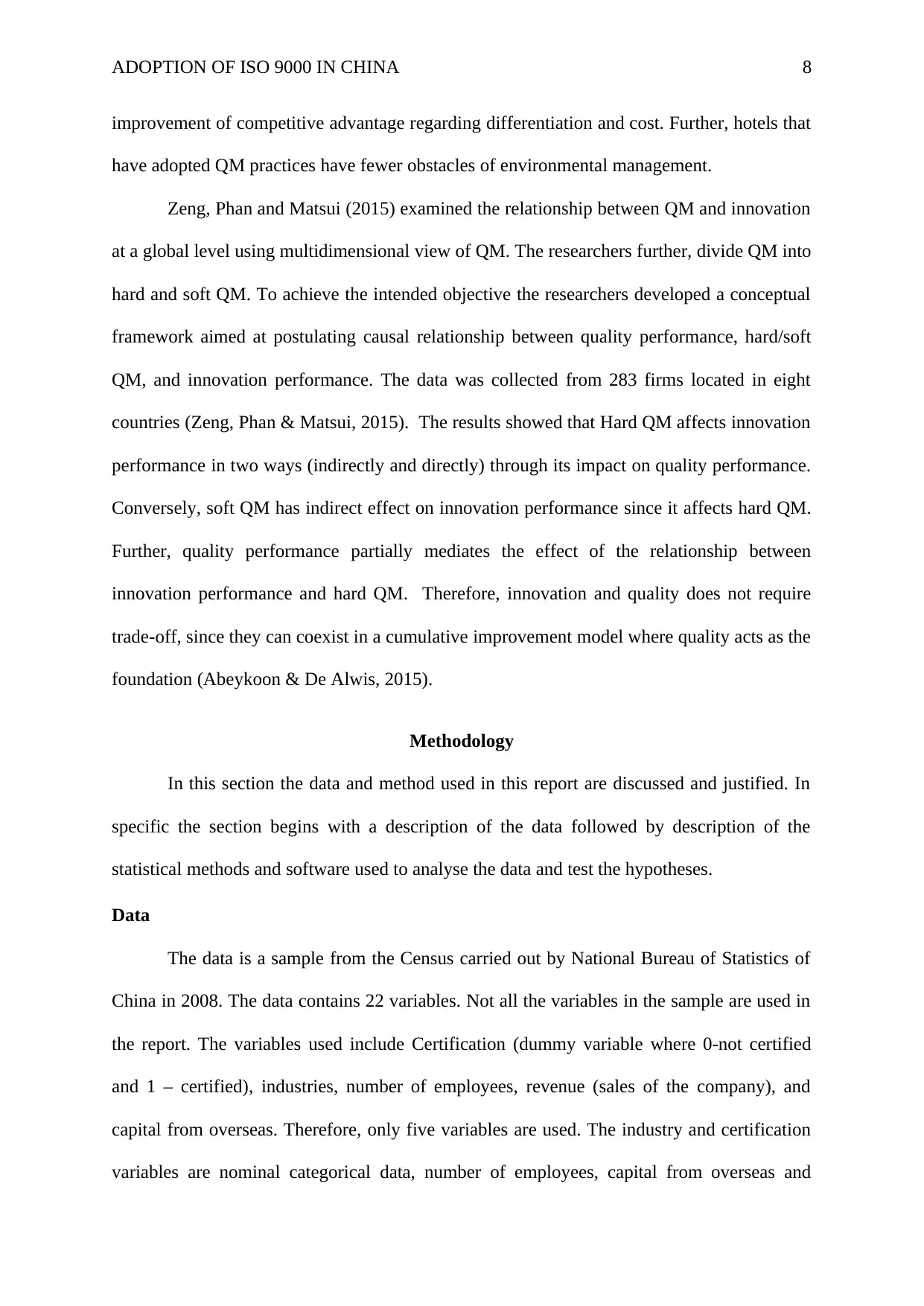
ADOPTION OF ISO 9000 IN CHINA 8
improvement of competitive advantage regarding differentiation and cost. Further, hotels that
have adopted QM practices have fewer obstacles of environmental management.
Zeng, Phan and Matsui (2015) examined the relationship between QM and innovation
at a global level using multidimensional view of QM. The researchers further, divide QM into
hard and soft QM. To achieve the intended objective the researchers developed a conceptual
framework aimed at postulating causal relationship between quality performance, hard/soft
QM, and innovation performance. The data was collected from 283 firms located in eight
countries (Zeng, Phan & Matsui, 2015). The results showed that Hard QM affects innovation
performance in two ways (indirectly and directly) through its impact on quality performance.
Conversely, soft QM has indirect effect on innovation performance since it affects hard QM.
Further, quality performance partially mediates the effect of the relationship between
innovation performance and hard QM. Therefore, innovation and quality does not require
trade-off, since they can coexist in a cumulative improvement model where quality acts as the
foundation (Abeykoon & De Alwis, 2015).
Methodology
In this section the data and method used in this report are discussed and justified. In
specific the section begins with a description of the data followed by description of the
statistical methods and software used to analyse the data and test the hypotheses.
Data
The data is a sample from the Census carried out by National Bureau of Statistics of
China in 2008. The data contains 22 variables. Not all the variables in the sample are used in
the report. The variables used include Certification (dummy variable where 0-not certified
and 1 – certified), industries, number of employees, revenue (sales of the company), and
capital from overseas. Therefore, only five variables are used. The industry and certification
variables are nominal categorical data, number of employees, capital from overseas and
improvement of competitive advantage regarding differentiation and cost. Further, hotels that
have adopted QM practices have fewer obstacles of environmental management.
Zeng, Phan and Matsui (2015) examined the relationship between QM and innovation
at a global level using multidimensional view of QM. The researchers further, divide QM into
hard and soft QM. To achieve the intended objective the researchers developed a conceptual
framework aimed at postulating causal relationship between quality performance, hard/soft
QM, and innovation performance. The data was collected from 283 firms located in eight
countries (Zeng, Phan & Matsui, 2015). The results showed that Hard QM affects innovation
performance in two ways (indirectly and directly) through its impact on quality performance.
Conversely, soft QM has indirect effect on innovation performance since it affects hard QM.
Further, quality performance partially mediates the effect of the relationship between
innovation performance and hard QM. Therefore, innovation and quality does not require
trade-off, since they can coexist in a cumulative improvement model where quality acts as the
foundation (Abeykoon & De Alwis, 2015).
Methodology
In this section the data and method used in this report are discussed and justified. In
specific the section begins with a description of the data followed by description of the
statistical methods and software used to analyse the data and test the hypotheses.
Data
The data is a sample from the Census carried out by National Bureau of Statistics of
China in 2008. The data contains 22 variables. Not all the variables in the sample are used in
the report. The variables used include Certification (dummy variable where 0-not certified
and 1 – certified), industries, number of employees, revenue (sales of the company), and
capital from overseas. Therefore, only five variables are used. The industry and certification
variables are nominal categorical data, number of employees, capital from overseas and
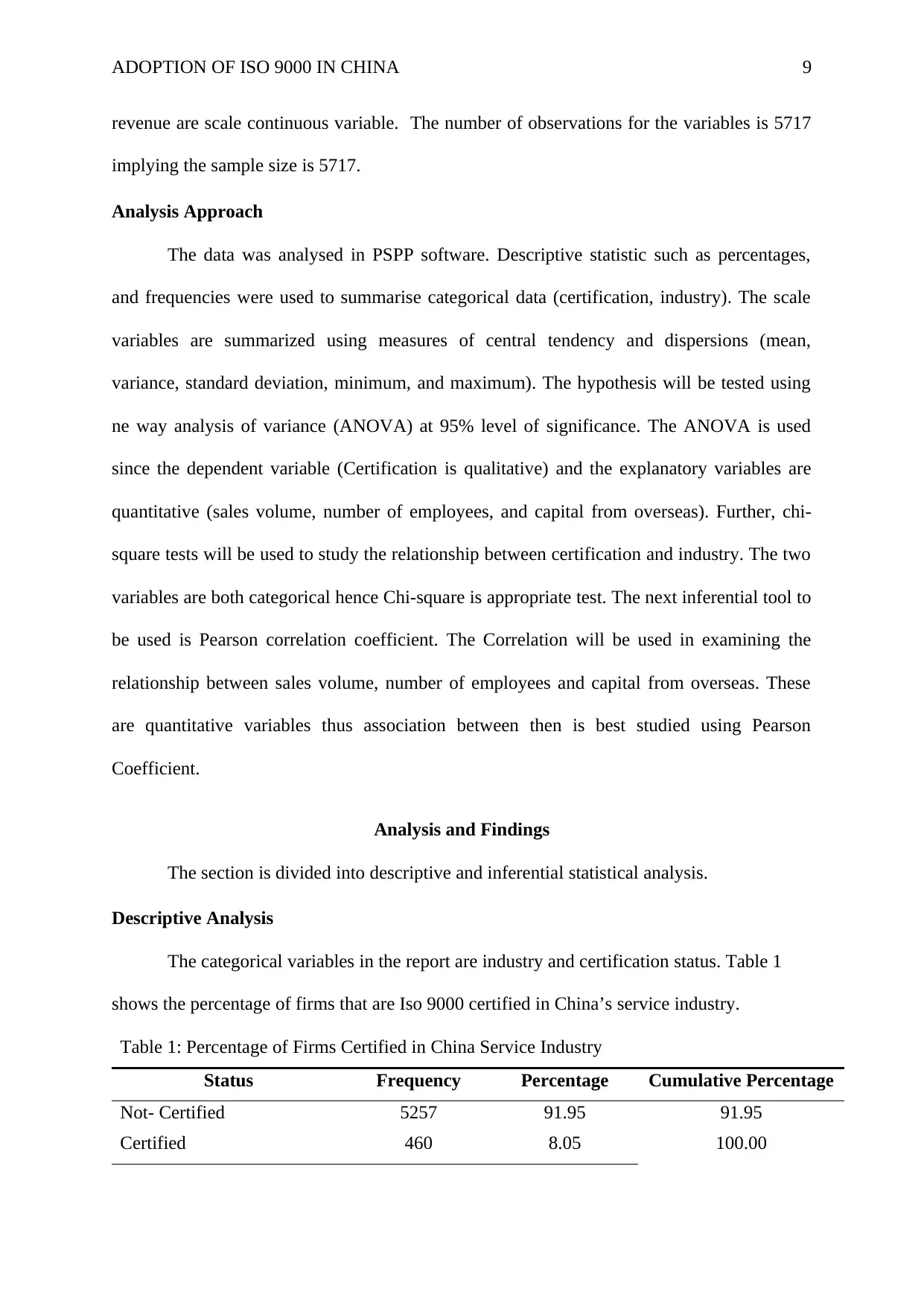
ADOPTION OF ISO 9000 IN CHINA 9
revenue are scale continuous variable. The number of observations for the variables is 5717
implying the sample size is 5717.
Analysis Approach
The data was analysed in PSPP software. Descriptive statistic such as percentages,
and frequencies were used to summarise categorical data (certification, industry). The scale
variables are summarized using measures of central tendency and dispersions (mean,
variance, standard deviation, minimum, and maximum). The hypothesis will be tested using
ne way analysis of variance (ANOVA) at 95% level of significance. The ANOVA is used
since the dependent variable (Certification is qualitative) and the explanatory variables are
quantitative (sales volume, number of employees, and capital from overseas). Further, chi-
square tests will be used to study the relationship between certification and industry. The two
variables are both categorical hence Chi-square is appropriate test. The next inferential tool to
be used is Pearson correlation coefficient. The Correlation will be used in examining the
relationship between sales volume, number of employees and capital from overseas. These
are quantitative variables thus association between then is best studied using Pearson
Coefficient.
Analysis and Findings
The section is divided into descriptive and inferential statistical analysis.
Descriptive Analysis
The categorical variables in the report are industry and certification status. Table 1
shows the percentage of firms that are Iso 9000 certified in China’s service industry.
Table 1: Percentage of Firms Certified in China Service Industry
Status Frequency Percentage Cumulative Percentage
Not- Certified 5257 91.95 91.95
Certified 460 8.05 100.00
revenue are scale continuous variable. The number of observations for the variables is 5717
implying the sample size is 5717.
Analysis Approach
The data was analysed in PSPP software. Descriptive statistic such as percentages,
and frequencies were used to summarise categorical data (certification, industry). The scale
variables are summarized using measures of central tendency and dispersions (mean,
variance, standard deviation, minimum, and maximum). The hypothesis will be tested using
ne way analysis of variance (ANOVA) at 95% level of significance. The ANOVA is used
since the dependent variable (Certification is qualitative) and the explanatory variables are
quantitative (sales volume, number of employees, and capital from overseas). Further, chi-
square tests will be used to study the relationship between certification and industry. The two
variables are both categorical hence Chi-square is appropriate test. The next inferential tool to
be used is Pearson correlation coefficient. The Correlation will be used in examining the
relationship between sales volume, number of employees and capital from overseas. These
are quantitative variables thus association between then is best studied using Pearson
Coefficient.
Analysis and Findings
The section is divided into descriptive and inferential statistical analysis.
Descriptive Analysis
The categorical variables in the report are industry and certification status. Table 1
shows the percentage of firms that are Iso 9000 certified in China’s service industry.
Table 1: Percentage of Firms Certified in China Service Industry
Status Frequency Percentage Cumulative Percentage
Not- Certified 5257 91.95 91.95
Certified 460 8.05 100.00
⊘ This is a preview!⊘
Do you want full access?
Subscribe today to unlock all pages.

Trusted by 1+ million students worldwide
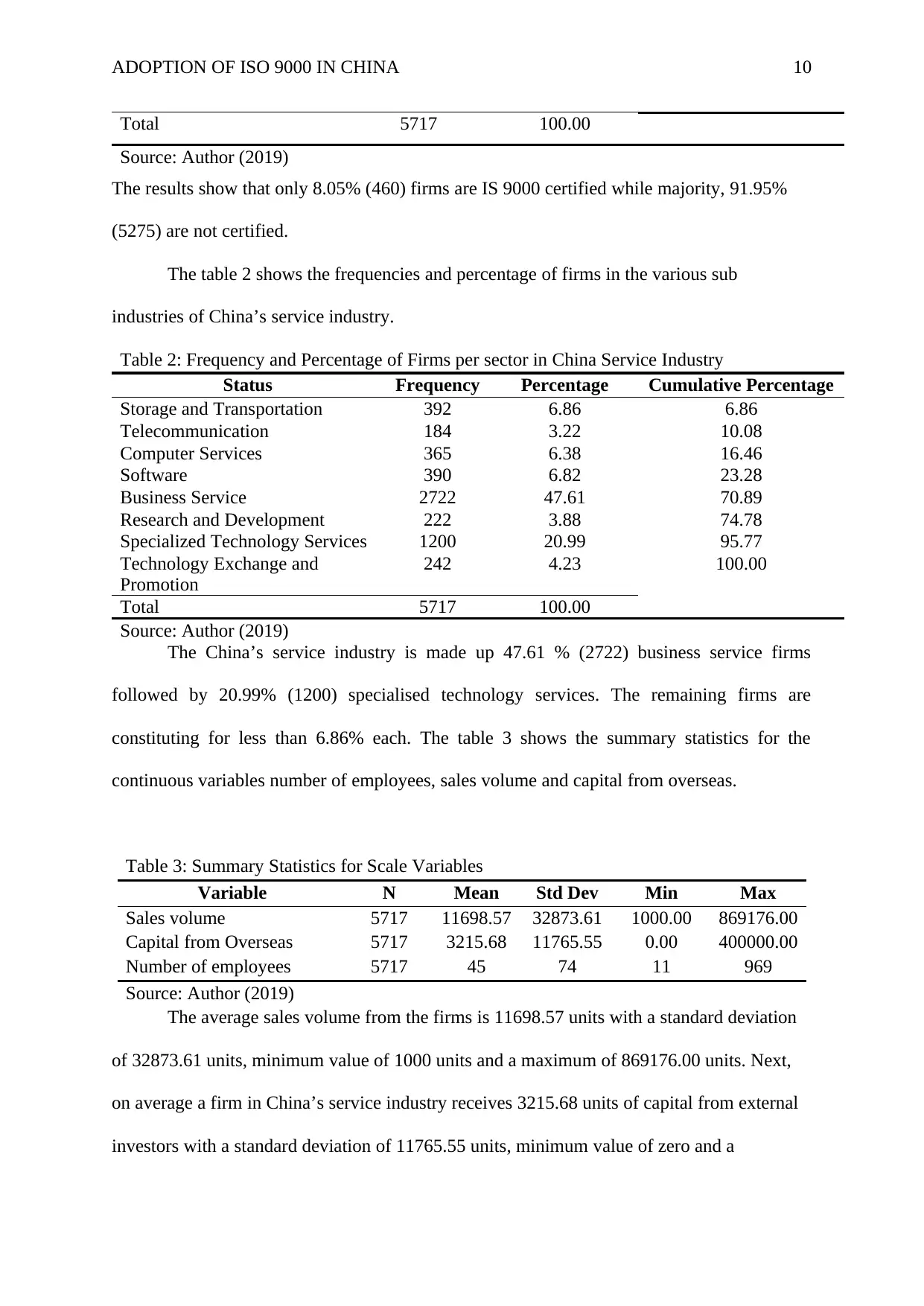
ADOPTION OF ISO 9000 IN CHINA 10
Total 5717 100.00
Source: Author (2019)
The results show that only 8.05% (460) firms are IS 9000 certified while majority, 91.95%
(5275) are not certified.
The table 2 shows the frequencies and percentage of firms in the various sub
industries of China’s service industry.
Table 2: Frequency and Percentage of Firms per sector in China Service Industry
Status Frequency Percentage Cumulative Percentage
Storage and Transportation 392 6.86 6.86
Telecommunication 184 3.22 10.08
Computer Services 365 6.38 16.46
Software 390 6.82 23.28
Business Service 2722 47.61 70.89
Research and Development 222 3.88 74.78
Specialized Technology Services 1200 20.99 95.77
Technology Exchange and
Promotion
242 4.23 100.00
Total 5717 100.00
Source: Author (2019)
The China’s service industry is made up 47.61 % (2722) business service firms
followed by 20.99% (1200) specialised technology services. The remaining firms are
constituting for less than 6.86% each. The table 3 shows the summary statistics for the
continuous variables number of employees, sales volume and capital from overseas.
Table 3: Summary Statistics for Scale Variables
Variable N Mean Std Dev Min Max
Sales volume 5717 11698.57 32873.61 1000.00 869176.00
Capital from Overseas 5717 3215.68 11765.55 0.00 400000.00
Number of employees 5717 45 74 11 969
Source: Author (2019)
The average sales volume from the firms is 11698.57 units with a standard deviation
of 32873.61 units, minimum value of 1000 units and a maximum of 869176.00 units. Next,
on average a firm in China’s service industry receives 3215.68 units of capital from external
investors with a standard deviation of 11765.55 units, minimum value of zero and a
Total 5717 100.00
Source: Author (2019)
The results show that only 8.05% (460) firms are IS 9000 certified while majority, 91.95%
(5275) are not certified.
The table 2 shows the frequencies and percentage of firms in the various sub
industries of China’s service industry.
Table 2: Frequency and Percentage of Firms per sector in China Service Industry
Status Frequency Percentage Cumulative Percentage
Storage and Transportation 392 6.86 6.86
Telecommunication 184 3.22 10.08
Computer Services 365 6.38 16.46
Software 390 6.82 23.28
Business Service 2722 47.61 70.89
Research and Development 222 3.88 74.78
Specialized Technology Services 1200 20.99 95.77
Technology Exchange and
Promotion
242 4.23 100.00
Total 5717 100.00
Source: Author (2019)
The China’s service industry is made up 47.61 % (2722) business service firms
followed by 20.99% (1200) specialised technology services. The remaining firms are
constituting for less than 6.86% each. The table 3 shows the summary statistics for the
continuous variables number of employees, sales volume and capital from overseas.
Table 3: Summary Statistics for Scale Variables
Variable N Mean Std Dev Min Max
Sales volume 5717 11698.57 32873.61 1000.00 869176.00
Capital from Overseas 5717 3215.68 11765.55 0.00 400000.00
Number of employees 5717 45 74 11 969
Source: Author (2019)
The average sales volume from the firms is 11698.57 units with a standard deviation
of 32873.61 units, minimum value of 1000 units and a maximum of 869176.00 units. Next,
on average a firm in China’s service industry receives 3215.68 units of capital from external
investors with a standard deviation of 11765.55 units, minimum value of zero and a
Paraphrase This Document
Need a fresh take? Get an instant paraphrase of this document with our AI Paraphraser
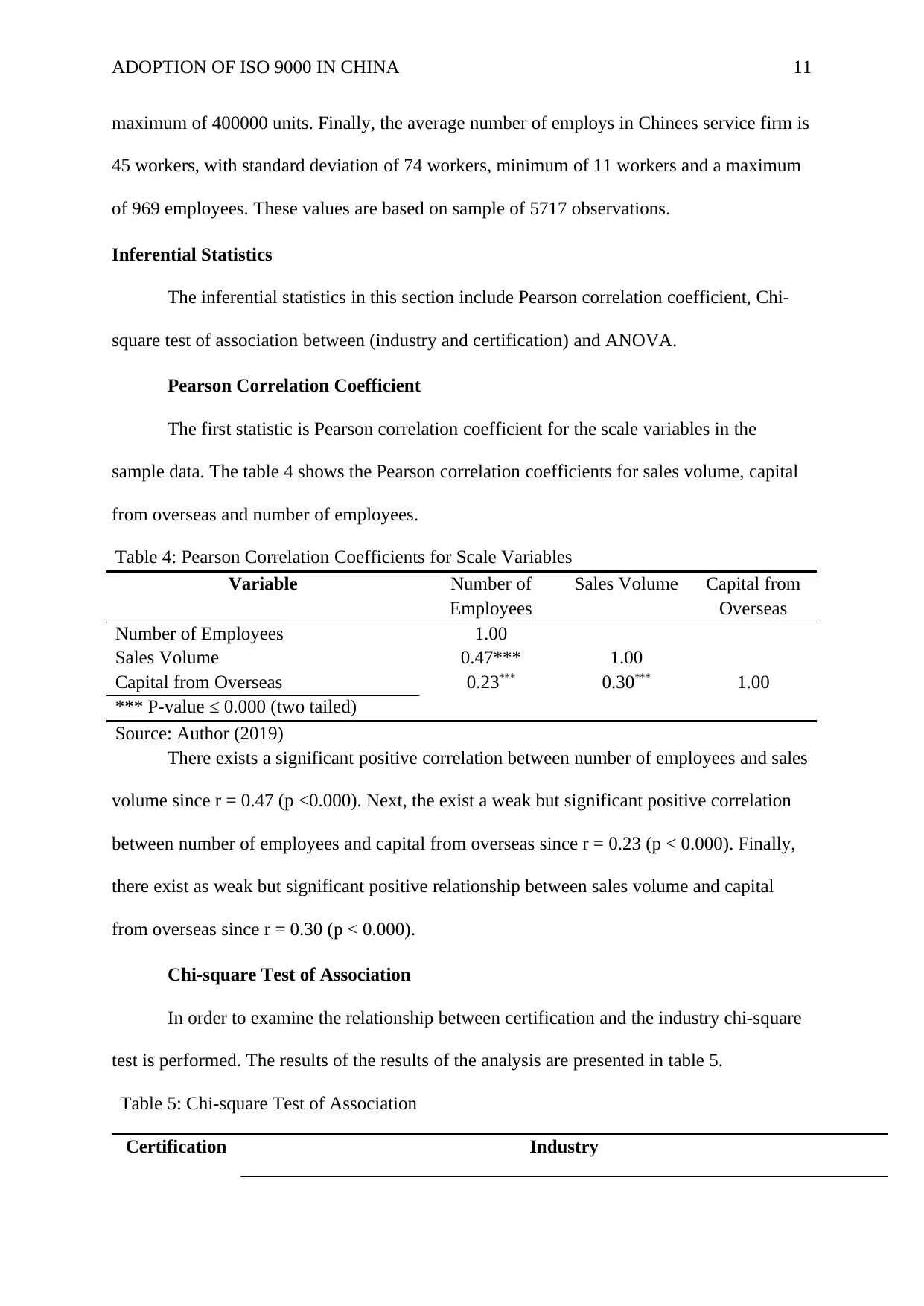
ADOPTION OF ISO 9000 IN CHINA 11
maximum of 400000 units. Finally, the average number of employs in Chinees service firm is
45 workers, with standard deviation of 74 workers, minimum of 11 workers and a maximum
of 969 employees. These values are based on sample of 5717 observations.
Inferential Statistics
The inferential statistics in this section include Pearson correlation coefficient, Chi-
square test of association between (industry and certification) and ANOVA.
Pearson Correlation Coefficient
The first statistic is Pearson correlation coefficient for the scale variables in the
sample data. The table 4 shows the Pearson correlation coefficients for sales volume, capital
from overseas and number of employees.
Table 4: Pearson Correlation Coefficients for Scale Variables
Variable Number of
Employees
Sales Volume Capital from
Overseas
Number of Employees 1.00
Sales Volume 0.47*** 1.00
Capital from Overseas 0.23*** 0.30*** 1.00
*** P-value ≤ 0.000 (two tailed)
Source: Author (2019)
There exists a significant positive correlation between number of employees and sales
volume since r = 0.47 (p <0.000). Next, the exist a weak but significant positive correlation
between number of employees and capital from overseas since r = 0.23 (p < 0.000). Finally,
there exist as weak but significant positive relationship between sales volume and capital
from overseas since r = 0.30 (p < 0.000).
Chi-square Test of Association
In order to examine the relationship between certification and the industry chi-square
test is performed. The results of the results of the analysis are presented in table 5.
Table 5: Chi-square Test of Association
Certification Industry
maximum of 400000 units. Finally, the average number of employs in Chinees service firm is
45 workers, with standard deviation of 74 workers, minimum of 11 workers and a maximum
of 969 employees. These values are based on sample of 5717 observations.
Inferential Statistics
The inferential statistics in this section include Pearson correlation coefficient, Chi-
square test of association between (industry and certification) and ANOVA.
Pearson Correlation Coefficient
The first statistic is Pearson correlation coefficient for the scale variables in the
sample data. The table 4 shows the Pearson correlation coefficients for sales volume, capital
from overseas and number of employees.
Table 4: Pearson Correlation Coefficients for Scale Variables
Variable Number of
Employees
Sales Volume Capital from
Overseas
Number of Employees 1.00
Sales Volume 0.47*** 1.00
Capital from Overseas 0.23*** 0.30*** 1.00
*** P-value ≤ 0.000 (two tailed)
Source: Author (2019)
There exists a significant positive correlation between number of employees and sales
volume since r = 0.47 (p <0.000). Next, the exist a weak but significant positive correlation
between number of employees and capital from overseas since r = 0.23 (p < 0.000). Finally,
there exist as weak but significant positive relationship between sales volume and capital
from overseas since r = 0.30 (p < 0.000).
Chi-square Test of Association
In order to examine the relationship between certification and the industry chi-square
test is performed. The results of the results of the analysis are presented in table 5.
Table 5: Chi-square Test of Association
Certification Industry
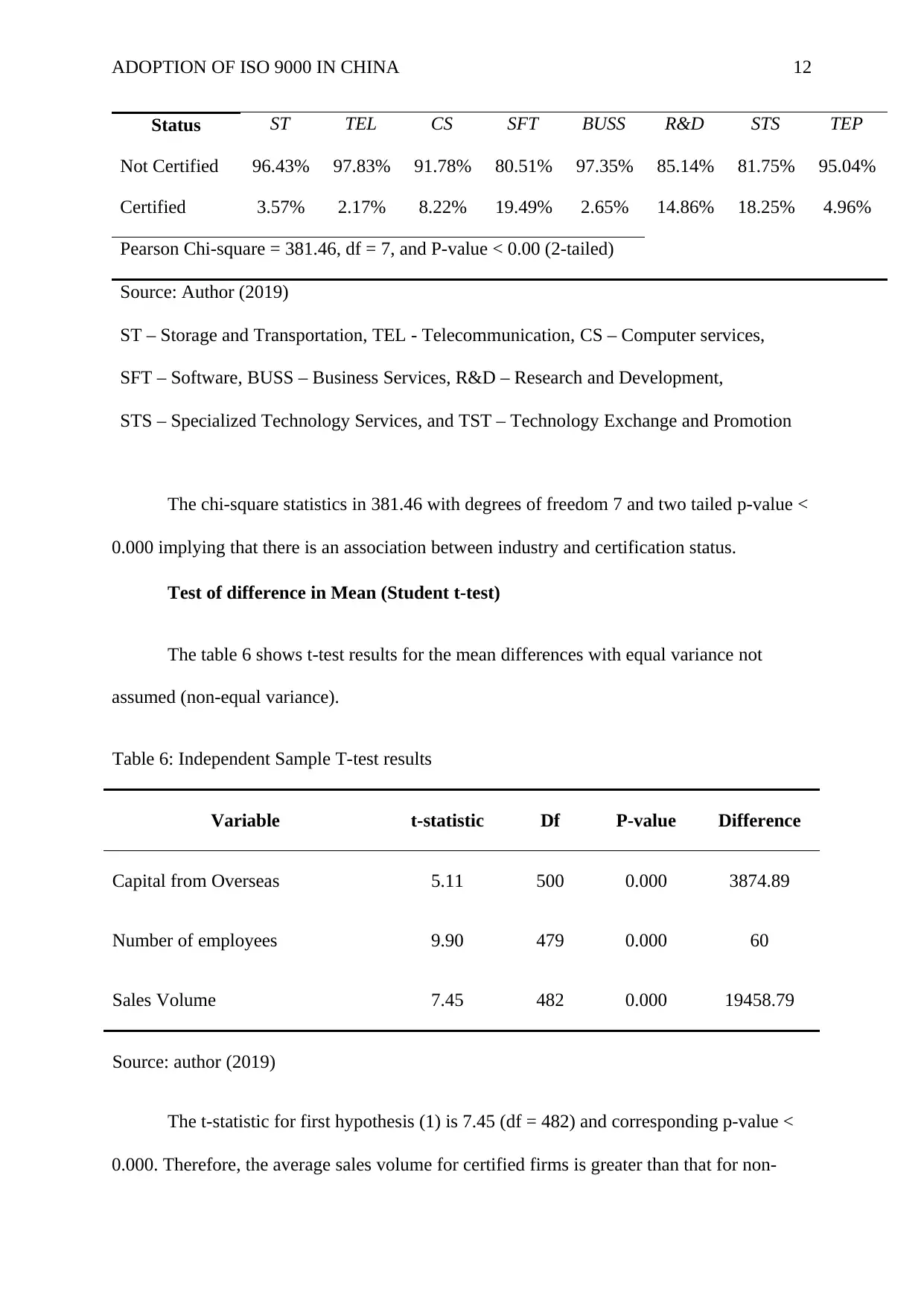
ADOPTION OF ISO 9000 IN CHINA 12
Status ST TEL CS SFT BUSS R&D STS TEP
Not Certified 96.43% 97.83% 91.78% 80.51% 97.35% 85.14% 81.75% 95.04%
Certified 3.57% 2.17% 8.22% 19.49% 2.65% 14.86% 18.25% 4.96%
Pearson Chi-square = 381.46, df = 7, and P-value < 0.00 (2-tailed)
Source: Author (2019)
ST – Storage and Transportation, TEL - Telecommunication, CS – Computer services,
SFT – Software, BUSS – Business Services, R&D – Research and Development,
STS – Specialized Technology Services, and TST – Technology Exchange and Promotion
The chi-square statistics in 381.46 with degrees of freedom 7 and two tailed p-value <
0.000 implying that there is an association between industry and certification status.
Test of difference in Mean (Student t-test)
The table 6 shows t-test results for the mean differences with equal variance not
assumed (non-equal variance).
Table 6: Independent Sample T-test results
Variable t-statistic Df P-value Difference
Capital from Overseas 5.11 500 0.000 3874.89
Number of employees 9.90 479 0.000 60
Sales Volume 7.45 482 0.000 19458.79
Source: author (2019)
The t-statistic for first hypothesis (1) is 7.45 (df = 482) and corresponding p-value <
0.000. Therefore, the average sales volume for certified firms is greater than that for non-
Status ST TEL CS SFT BUSS R&D STS TEP
Not Certified 96.43% 97.83% 91.78% 80.51% 97.35% 85.14% 81.75% 95.04%
Certified 3.57% 2.17% 8.22% 19.49% 2.65% 14.86% 18.25% 4.96%
Pearson Chi-square = 381.46, df = 7, and P-value < 0.00 (2-tailed)
Source: Author (2019)
ST – Storage and Transportation, TEL - Telecommunication, CS – Computer services,
SFT – Software, BUSS – Business Services, R&D – Research and Development,
STS – Specialized Technology Services, and TST – Technology Exchange and Promotion
The chi-square statistics in 381.46 with degrees of freedom 7 and two tailed p-value <
0.000 implying that there is an association between industry and certification status.
Test of difference in Mean (Student t-test)
The table 6 shows t-test results for the mean differences with equal variance not
assumed (non-equal variance).
Table 6: Independent Sample T-test results
Variable t-statistic Df P-value Difference
Capital from Overseas 5.11 500 0.000 3874.89
Number of employees 9.90 479 0.000 60
Sales Volume 7.45 482 0.000 19458.79
Source: author (2019)
The t-statistic for first hypothesis (1) is 7.45 (df = 482) and corresponding p-value <
0.000. Therefore, the average sales volume for certified firms is greater than that for non-
⊘ This is a preview!⊘
Do you want full access?
Subscribe today to unlock all pages.

Trusted by 1+ million students worldwide
1 out of 17
Related Documents
Your All-in-One AI-Powered Toolkit for Academic Success.
+13062052269
info@desklib.com
Available 24*7 on WhatsApp / Email
![[object Object]](/_next/static/media/star-bottom.7253800d.svg)
Unlock your academic potential
Copyright © 2020–2025 A2Z Services. All Rights Reserved. Developed and managed by ZUCOL.




